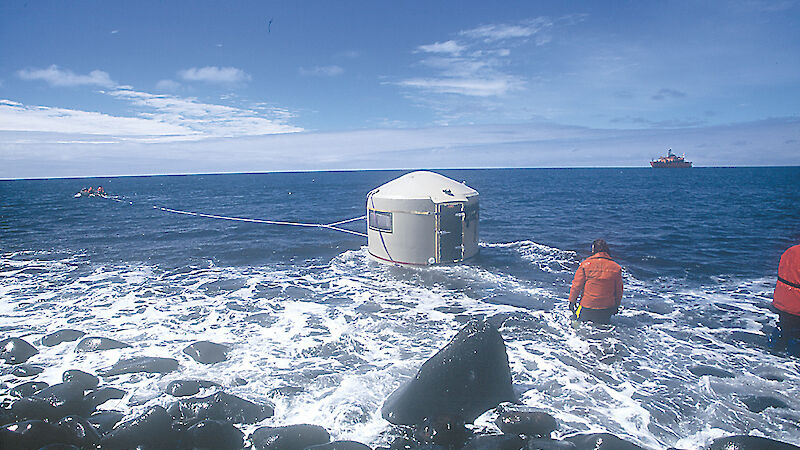When plans for a field season for scientists on Heard Island were declared, the hunt was on for a sturdy hut that was waterproof, portable, cheap to produce and able to be transported by a variety of means.
Experience has shown that reliance on tents to accommodate field workers in the extreme weather conditions on Heard Island is a fraught business. It is guaranteed to involve frequent re-pitching, chasing of gear and constant attempts to dry clothing and sleeping bags in conditions that will try the most experienced expeditioner. To make the best of the time on the island, it was essential to ensure a better standard of accommodation and workspace for members of the 2000–01 Heard Island ANARE.
And so was born the water tank hut — brainchild of AAD Field Equipment and Training Officer, Rod Ledingham. After all, what better for a rainy climate than a watertight container adapted as a hut, and what could be more watertight than a rainwater tank?
The concept was trialled a number of years ago on Macquarie Island when a 2.7metre diameter high-density polyethylene water tank was converted into a small hut for Davis Point as a refuge for a marine debris collection program. The hut was positioned by helicopter and has proven to be most effective.
The main problem with the early tank model was the great deal of condensation on the interior walls, which soaked bedding and fittings. This was partially solved by retrofitting closed cell foam matting on the walls. On investigating the possibilities of insulating, it was discovered there was a system whereby a secondary insulating layer could be cast on the interior during the rotary moulding process
The trial tank came out like a melted gumboot, but on the second attempt a perfect specimen with approximately 12mm of insulation was formed. This 3.4 metre prototype was fitted out and found able to hold 6 bunks which could be moved and used as shelves or workbenches. There was also enough room for a set of 60cm wide shelves from floor to ceiling. Windows were doubleglazed with polycarbonate attached to the interior and exterior surfaces. A door was fitted about 40cm up from the floor so that the base remained waterproof. Ventilators and roof hatches were fitted.
The polytank is virtually indestructible and therefore ideal for deployment in places like Heard Island. It is also relatively cheap ($2,000 to $3000 with insulation) compared with the now famous fibreglass ‘Apple’ huts which are constructed as a series of panels and bolted together.
Fifteen tank huts have been used on Heard Island this season, delivered to Atlas Cove, Brown Glacier and Spit Bay by helicopter. Several were towed in the water by inflatable rubber boats and lifted onto the re-supply vessel, their self righting capability proven in trials before going to Heard Island.
Early reports from expeditioners are positive but we'll have more news on life in a water tank in the next edition of Australian Antarctic Magazine.
Rod Ledingham1 and Rob Easther2
1. Field Equipment and Training Officer, Australian Antarctic Division
2. Field Operations Manager, Australian Antarctic Divison

